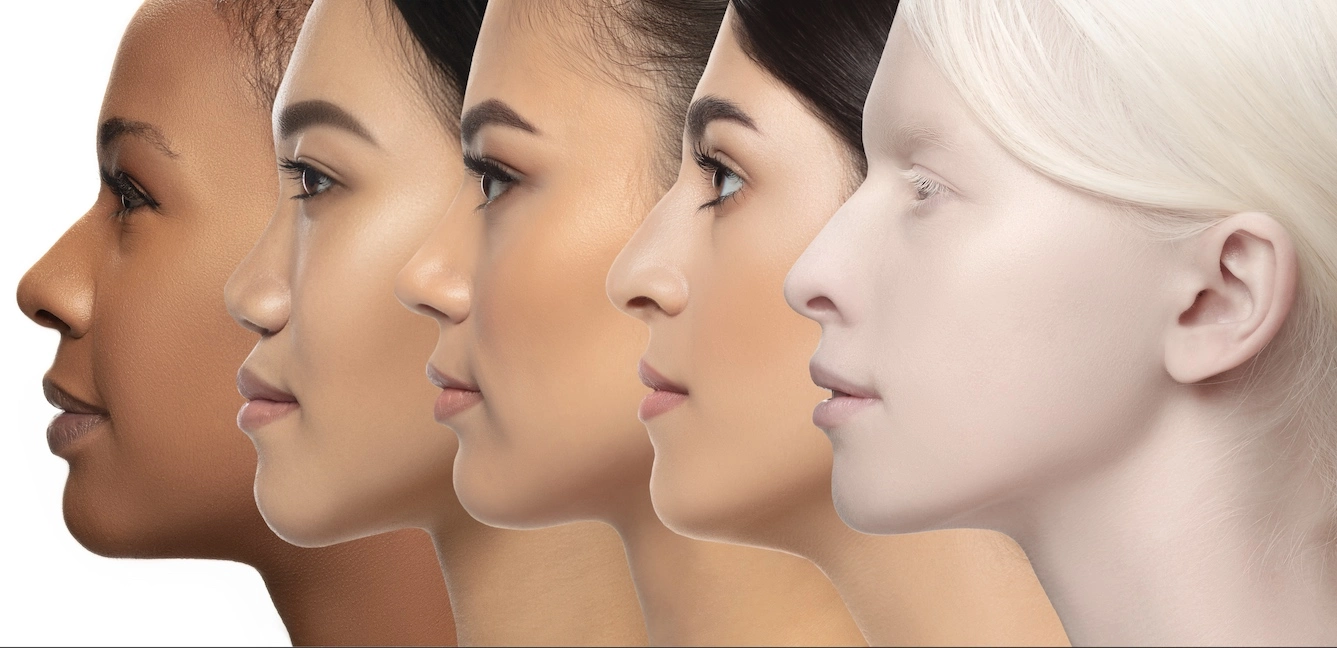Table of Contents
Rhinoplasty, commonly known as a nose job, is a popular cosmetic surgical procedure aimed at reshaping and enhancing the appearance of the nose. Ethnic rhinoplasty, on the other hand, is a specialized approach that considers the unique characteristics and anatomical differences of various ethnicities when performing nasal surgery.
This blog will delve into the nuances of ethnic rhinoplasty, exploring the distinctions between cosmetic and functional rhinoplasty, as well as the variations between Caucasian, Hispanic/Latino, African American, Asian, and Middle Eastern noses.
Difference Between Cosmetic and Functional Rhinoplasty
Cosmetic rhinoplasty is primarily focused on enhancing the aesthetic appearance of the nose, addressing concerns such as a dorsal hump, a drooping tip, or asymmetry. This type of rhinoplasty aims to improve the balance and proportion of the nose in relation to the rest of the facial features, enhancing overall facial harmony.
Functional rhinoplasty, on the other hand, focuses on enhancing nasal function and addressing breathing difficulties. This may involve procedures such as septoplasty to correct a deviated septum, turbinate reduction to alleviate nasal congestion, or nasal valve repair to enhance airflow through the nostrils. Functional rhinoplasty aims to combine aesthetic improvements with functional benefits, ensuring that the patient not only looks better but also breathes easier.
About Hispanic/Latino Rhinoplasty
Hispanic rhinoplasty is a specialized surgery designed to address the unique nasal features and aesthetic concerns of Hispanic patients. Because there is significant diversity within the Hispanic/Latino population, including variations in skin thickness, cartilage strength, and nasal shape, it’s essential to take an individualized approach. This type of rhinoplasty aims to refine the nose while preserving the patient’s ethnic identity, ensuring the final result complements their overall facial structure. By understanding the distinct anatomy and preferences of Hispanic patients, surgeons can achieve natural-looking outcomes that respect cultural and personal aesthetics.
About Asian Rhinoplasty
Asian rhinoplasty is a specialized form of facial plastic surgery that takes into account the unique bone structure and natural features commonly seen in Asian noses. Unlike Western rhinoplasty, which often focuses on reducing or reshaping the nose, Asian rhinoplasty typically involves bridge augmentation to enhance the height and definition of the nasal dorsum, while maintaining ethnic harmony. The goal is not to change the patient’s identity, but to refine and enhance the nose in a way that complements their existing features and preserves cultural authenticity.
What Is Middle Eastern Rhinoplasty?
Middle Eastern rhinoplasty is a type of nose reshaping surgery that addresses the unique anatomical characteristics and aesthetic goals of Middle Eastern patients. This procedure often involves refining a prominent dorsal hump, adjusting the nasal tip, or improving overall symmetry while ensuring the results remain balanced with other facial features. The approach emphasizes preserving ethnic identity while achieving a more harmonious and proportionate appearance.
Surgical Techniques for Ethnic Nose Jobs
When performing ethnic rhinoplasty, surgeons may choose between open and closed surgical techniques, depending on the patient’s anatomy and goals. Open rhinoplasty offers greater visibility and precision, which can be particularly beneficial for addressing complex cases, such as a deviated septum, or performing a revision rhinoplasty. Closed rhinoplasty, which involves internal incisions, may be better suited for more minor refinements. Patients with thick skin often require careful structural support and contouring to achieve the desired shape without compromising long-term results. Regardless of the approach, these procedures are typically performed under general anesthesia to ensure patient comfort and safety throughout the surgery.
In the case of African American rhinoplasty, specialized techniques such as cartilage grafting, alar base reduction, and dorsal augmentation are often employed to address specific concerns, including nostril width, nasal tip projection, and nasal bridge height. These techniques allow for precise modifications that preserve the patient’s ethnic identity while achieving the desired aesthetic goals.
Benefits of Ethnic Rhinoplasty Procedures
Ethnic rhinoplasty offers numerous benefits for individuals seeking nose surgery that respects and enhances their unique ethnic features. By tailoring surgical techniques to the specific characteristics of the patient’s nose, ethnic rhinoplasty can achieve more harmonious and proportionate results that complement the individual’s facial features.
- Preserves Ethnic Identity: The surgery is designed to refine the nose while honoring the patient’s unique heritage.
- Harmonious Results: Creates a nose that is in balance with the patient’s other facial features.
- Customized Approach: Tailors techniques to the individual’s specific anatomy and aesthetic goals.
- Boosts Self-Confidence: Patients feel more confident with a nose that is both aesthetically pleasing and true to their unique identity.
Schedule an Ethnic Rhinoplasty Consultation and Celebrate Your Cultural Identity!
At Texas Sinus & Snoring, your ethnic rhinoplasty journey begins with an initial consultation where we take time to understand your goals, review your medical history, and evaluate your facial anatomy. We consider each patient’s ethnic background carefully to create a customized surgical plan that respects cultural features while enhancing nasal harmony. During this consultation, we also discuss realistic expectations, including the healing process and the possibility of residual swelling in the months following surgery. While healing times can vary, most patients begin to see noticeable improvements as swelling gradually subsides and the final shape takes form.
Conclusion: Ethnic Rhinoplasty Surgery
Ethnic rhinoplasty is a specialized approach to nasal surgery that considers the unique anatomical features and characteristics of different ethnicities. By understanding the differences between cosmetic and functional rhinoplasty, as well as the distinct characteristics of Caucasian, African American, and other ethnic noses, surgeons can deliver tailored treatment plans that optimize both aesthetic outcomes and functional improvements.
Ethnic rhinoplasty offers a personalized and culturally sensitive approach to rhinoplasty nose surgery, ensuring that patients receive results that enhance their natural beauty while preserving their ethnic identity.
By embracing the diversity of nasal anatomy and employing innovative techniques, ethnic rhinoplasty continues to evolve as a valuable tool for achieving successful and satisfying outcomes in patients of all backgrounds.
Ethnic Rhinoplasty FAQs
Why is the nose so crucial for preserving ethnic identity?
The nose plays a central role in defining a person’s overall appearance because it sits at the center of the face and directly influences how the unique facial features come together. The nasal structure often varies across different ethnicities, contributing significantly to individual identity. Preserving these elements during rhinoplasty ensures that enhancements still reflect the patient’s heritage and natural appearance.
How long does ethnic rhinoplasty recovery take?
Like many plastic surgery procedures, recovery from ethnic rhinoplasty typically takes about two to three weeks for initial healing. During this time, patients may experience swelling and mild discomfort, which can be managed with prescribed pain medication. Although most visible swelling resolves within a few weeks, full refinement of the nose can continue for several months.
Is the ethnic rhinoplasty cost higher compared to standard rhinoplasty?
The cost of surgery for ethnic rhinoplasty patients can sometimes be higher than traditional rhinoplasty due to the additional skill, time, and customization required. Because ethnic groups often present with specific facial characteristics and unique anatomical needs, surgeons must tailor techniques to match the patient’s ethnic features rather than following the more standardized approach used in Caucasian rhinoplasty.
Why is it crucial to choose a board-certified facial plastic surgeon?
Selecting a board-certified plastic surgeon is crucial for ensuring safe and professional care—especially when ethnic characteristics are a central part of the procedure. These surgeons are often trained in both facial and neck surgery and have the experience needed to honor and preserve a patient’s cultural identity while achieving desired improvements. A board-certified surgeon understands the nuances involved in respecting ethnicity while delivering refined, balanced results.
Ready to Breathe Freely Again?

By Dr. Ben Cilento, ENT
August 15, 2025



